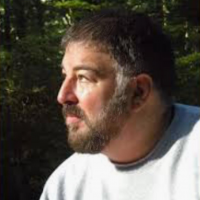
Martial Artist’s Guide to Getting Older and Defending Yourself … In a Nutshell
by Keith Pascal
You’ve been into martial arts for years, you’re getting older, yet you don’t want to lose your skills as you age.
Isn’t there a way to be able to defend yourself all the way to the end of a very long life?
Hey, I would love to tell everyone that there is a secret to staying young … and never dying, but you and I are both more realistic than that. Agreed?
As martial artists, we know that as we age, certain abilities will decline. Or will they?
And do we know this for sure?
Martial Artists in Denial
First, let’s talk denial.
 I see all sorts of martial artist who actually deny that they are getting old. It’s not that they are resisting nature’s way of evening the playing field, but they absolutely don’t believe that it’s happening to them.
I see all sorts of martial artist who actually deny that they are getting old. It’s not that they are resisting nature’s way of evening the playing field, but they absolutely don’t believe that it’s happening to them.
They do everything they can to keep up with the younger ones. Really, it’s not that they are resisting aging in a healthy, do-what-you-can-to-stay-healthy-and-vibrant sort of way; they actually believe that they have all that they had when they were 22.
“It just ain’t so.”
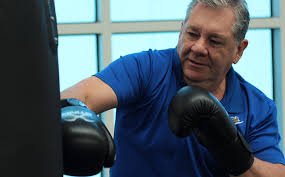 I’m not saying we shouldn’t do everything that we can to stay youthful, and keep our self-defense abilities as long as we can, but we have to be realistic.
I’m not saying we shouldn’t do everything that we can to stay youthful, and keep our self-defense abilities as long as we can, but we have to be realistic.
And we can be truly honest with ourselves, as we fight to keep improving. Yes, you read that right … you continue to try to improve, as you age. It’s who you are.
Once we get over the unhealthy kind of denial, we then have a choice: we can choose to be angry about the body’s slow decline, or we can continue our martial journey of ever improving.
We have a quest to be able to defend ourselves and our loved ones with more and more efficiency. The ironic fact is that as we get really old, we MUST deal with these situations more efficiently. We don’t have a choice.
This is kind of what makes a “martial arts master,” right?
Adjust Your Martial Arts As You Age
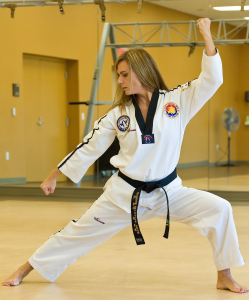 Again, we resist going downhill with all our might, but as our body changes, we change with our body.
Again, we resist going downhill with all our might, but as our body changes, we change with our body.
Our tactics and strategies must adjust for our age. In our quest for “ever better,” and continued improvement, we don’t let age limit the overall goal. And we are smart enough to work with what we’ve got.
I can’t emphasize this enough, even if I sound repetitive…. We adjust for age. And we’re reasonable about what we can and can’t do.
Note: A little later in this article, I’m going to provide some true examples of martial artists who “aged well.” Their stories are impressive … to me.
We don’t compare our limitations with other martial artists’. We all age at different rates. One person’s 70 could be another person’s 62 … or 83.
So, How Do We Improve Self-Defense Abilities As We Age?
First, you need to perform a self-assessment of age problems or limitations. There is no use straining and hurting part of your body if it can be avoided.
For example:
- If you have bursitis in the shoulder, then you don’t want to use a range of motion that could hurt you, or incapacitate your shoulder. Keep your elbow oriented downward and don’t open your arm wide, with your elbow stretching behind your shoulder. More constrained movements will be better for your shoulder.
- If you have horrible arthritis in your right hand, and it causes pain to press against the knuckles, then you have to avoid “fist” punching with that hand. Develop an open-palm strike with that hand, and add in an eye jab, but only jab with the fingers that aren’t affected by arthritis.
Know these limitations in advance.
Figure out all your work-arounds in advance.
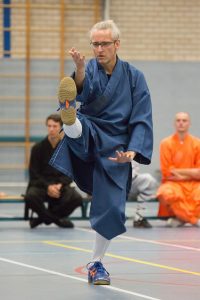 Let’s say one of your legs can’t support your weight. Then it only makes sense for you to tell yourself … not to use that leg to support your weight.
Let’s say one of your legs can’t support your weight. Then it only makes sense for you to tell yourself … not to use that leg to support your weight.
It seems obvious.
What’s not so obvious is that you might have to adjust which leg leads based on this limitation. And you might have to take shorter steps and rely on pivoting in your footwork.
Still, maybe the leg that can’t support your weight for a higher kick could support you long enough for a quick, low kick to your attacker’s shins or knees. Or maybe you don’t want to take that risk, unless there is no other alternative in an actual altercation.
Step by step, you need to analyze what is and isn’t working, because of your age. Add in any other limitations not age related.
Continue to Tweak Your Martial Arts Techniques
Even though I don’t want you to limit yourself to one set of moves, you do have to restrict yourself in certain ways, as you age.
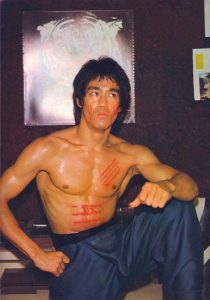 On the one hand, we need to be like Bruce Lee and “Use No Way as Way, and Have No Limitation As Limitation.”
On the one hand, we need to be like Bruce Lee and “Use No Way as Way, and Have No Limitation As Limitation.”
So, ideally, we’d be able to react with our arms and legs in any position, anywhere, and have the perfect technique materialize on the way to the attacker.
Ideally.
The simple fact that your body is getting old makes this a little less than the ideal situation. So, as mentioned before, we adjust.
For example one of my arms isn’t working quite right for a check, when the thumb is pointing down. Any pressure against that arm causes pain.
Note: That’s why I went to physical therapy. And I’m still working on the exercises for rehabilitation.
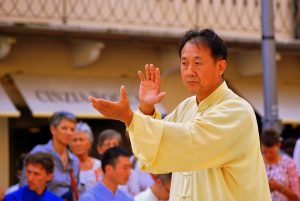 So, with that arm, I use an open-hand check, with fingers up, palm hitting my opponent’s arm, AND I use what’s called a tan-sao, a palm-up check, with elbow down.
So, with that arm, I use an open-hand check, with fingers up, palm hitting my opponent’s arm, AND I use what’s called a tan-sao, a palm-up check, with elbow down.
I avoid a wing-arm check (bong sao), that might have to take a hit with force.
I don’t necessarily want to rely on these two moves; I’d like to simply allow my body and brain to respond with anything that I have learned. Because of the injury (trying to support a player piano), I have been focusing on the above two checks, for my safety.
As I get closer and closer to 60, I know what has changed in my martial abilities from the mid 1980s.
I need to practice for my current abilities. Eliminate the weaker stuff and beef up what you still have going for you.
And maybe even grab a perceived stereotype about older martial artists and overtrain in that area … for a surprise or two.
Let’s talk about that for a minute….
What Are Those Stereotypes of Older Folk?
In another article, we already talked about improving in one area that your enemy might erroneously stereotype you. Our example was being fast, even though you’re overweight.
What about getting older?
What do people assume about “us”?
Well, once we get old, it’s assumed that certain changes will happen:
- worse eyesight
- loss of muscle mass
- loss of strength
- slowing down, not as speedy
- worse balance, and loss of stability
- forgetting techniques
- loss of stamina
First, let’s devote a sentence or three for each of the above, and again, in a nutshell, see how each affects us.
Afterwards, I’d like to give you examples of several older martial artists who still make/made it work. By the way I describe each, you’ll get an idea of what you can keep working on.
Let’s continue:
 Worsening eyesight — I don’t use my eyes much to fight, anyway, do you? Once you’re in close for really tight fighting, then sight doesn’t really matter; it’s all moving too fast to look. So, we rely on feeling, like in chi sao (sticky hands) or push hands.
Worsening eyesight — I don’t use my eyes much to fight, anyway, do you? Once you’re in close for really tight fighting, then sight doesn’t really matter; it’s all moving too fast to look. So, we rely on feeling, like in chi sao (sticky hands) or push hands.
Loss of muscle mass — It might be time to learn “finesses” with your moves. You might no longer have the mass to be able to fight and overpower your opponent into a wrist lock. You might have to loosen up your enemy with a punch to the face, and then snap on a joint lock.
Loss of strength — Martial arts has never been about strength, right? My wife is 5’2” and in her 40’s. Yet she has a very powerful punch. It’s not about the muscles. Or it shouldn’t be.
Slowing down, not as speedy — If you mean darting in and out, I agree. You could be slowing down, getting ever closer to a geriatric shuffle. No more flying through the air for you; you decide to be nicer on your joints. But as for quick hands … those don’t need to slow down. You can be old … and still have a speedy punch …. or eye jab. (If you’re really old, then maybe that eye jab will only move two inches; fine! You’ll figure out a way to get your fingers close enough to your enemy’s eyeballs.)
Worse balance, and loss of stability — This is going to happen, eventually. Work on keeping it, but figure out what you’re going to do, once it goes. You’ll practice both keeping an enemy at bay, maybe with an umbrella, and how to hang on someone and use their balance as yours, while you hit vulnerable areas.
Forgetting techniques — It’s bound to happen; so what? I’m not a big fan of knowing a million techniques, anyway. As long as you have a “set” (repertoire) that works for you, what do you care if it’s shrinking? Trust that your body will know how to respond with … “something.” And in a real life situation, as long as it works, “something” is enough.
Loss of stamina — You don’t want to keep up with the youngsters, do you? I mean, let those twenty-somethings do all the work. Conserve your energy! Look, from the point of contact, a real fight shouldn’t last more than a couple of seconds. That’s all you need … stay active for a couple of seconds, and the fight will be over … one way or another.
 So, Is It Hopeless?
So, Is It Hopeless?
Well, none of us, as far as I know, is going to live forever.
But as long as we’re on this earth, we can have a nice ride.
To stay safe, we’re making our martial abilities work for us.
When we practice martial arts, we continue to learn efficiency and ways to make the younger set do all the work….
We learn that “move with a purpose,” really means, don’t move when you don’t have to.
Every time, while practicing, we get into a struggle with our practice partner, we know that this is an area that could use some major improvement.
We really do want it to look easy, as we age.
And we want all of this to translate to real self-defense situations. Because we are so efficient and surprising as older people, we have a chance in a real encounter.
Let’s end today’s discussion with a couple of really quick stories:
1) Daniel Lee was a Bruce Lee student. Once I saw him go around a circle of blackbelts, and ask them to clap their hands and touch his hand before he touched them on the chest.
In other words, with hands ready to clap together, they had to block his attempt to speedily touch his chest.
Not one guy was able to touch his hands.
He was that blindingly fast.
And he was an old man, (close to 80?) who had just had two knee replacements.
(He didn’t step. It was all with his arms reaching in.)
Hmmm.
2) Wally Jay, The Founder of Small Circle Jiu Jitsu once shook my hand, or rather I shook his, as he snapped on a joint lock that was … painful.
He could effect a lock, and he was over 80 years old, if I remember. And it was an effective lock. He had the touch … the finesse. It was NOT about power.
 3) Once, Dan Inosanto told us of the story of one of his Filipino teachers.
3) Once, Dan Inosanto told us of the story of one of his Filipino teachers.
The guy was an old, old man, but her heard that a California gang was robbing senior citizens of their social security money.
So, one day, the old teacher put a $50 bill in his shirt pocket, sticking up for all to see, and went for a walk.
The story ends with the man detaining four gang members against a wall until the police came.
The old teacher had nothing more than his walking cane, which he used to quickly tap the bad guys, whenever they tried to leave.
That’s right … they had tried to rob him.
And in his 80’s, he kept them corralled, until they could be taken away.
Finally … my teacher, Steve Golden, is 75.
In the next post, I’d like to tell you about one exercise (drill) that he does for practical martial arts.
It really is amazing … but something you can practice … as you get older.
And Steve is 75.
Great for the younger martial artists who really want to learn to deal with multiple attackers.
Talk to you then,
Keith
PS Not signed up to the FREE Advantage Martial Arts Newsletter? You should be. Remember, you get the ebooklet Elbow Strike Counters, as soon as you join. Sign up in the upper right of this page. (I will never SPAM you. I promise.)
Leave A Reply (4 comments so far)
Doug Wire
8 years ago
Excellent, I appreciate your take on getting older. My teacher told to do what you can and make it better and don’t worry about what you can’t do. I turn 66 in December. I refuse to quit!
Keith Pascal
8 years ago
Quit? Never!!
(I applaud your attitude.)
But as we get older, let’s look for ways to accomplish the same level of self-defense with less muscle work.
We need to truly “finesse” the younger fighters with our precision.
Bruce Lee’s advice to “move with a purpose” becomes oh so important, as we lose some of our muscle mass and vibrant, young athletic movement.
May we both defend ourselves efficiently into and past our 80s!!
Keith
Alan Lewis
8 years ago
Hi Keith,its an interesting subject and must admit have a knee injury at the moment and knocking onto my 68th birthday next week. Yes I completely agree as a martial artist studying Shotokan since 1968 non stop.
I do feel much younger than I am but now must be realistic and understand that age will have an effect on my ability.
Regards Alan. Crofton Shotokan school of karate.
Affiliated to SEKU.
Keith Pascal
8 years ago
Alan,
I just heard a news piece on the radio that exercising the knee … like with jogging …
it doesn’t wear down the joint, but rather helps it stay young.
Very interesting.
Shotokan is a very “active,” hard style. I recommend that as you get older, you constantly make adjustments … looking for economical and efficient ways to get the same effect with less effort.
Just a suggestion … from someone getting ever closer to 60 😉
Keith